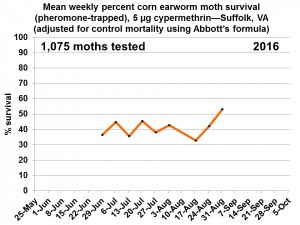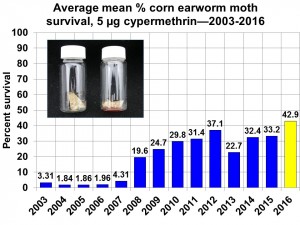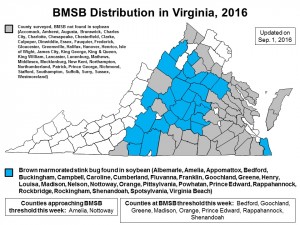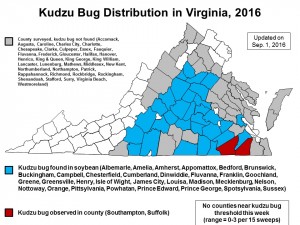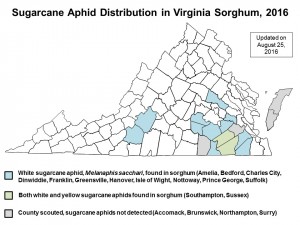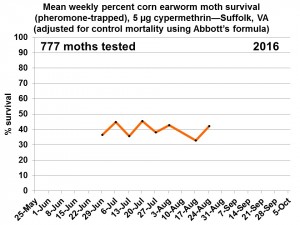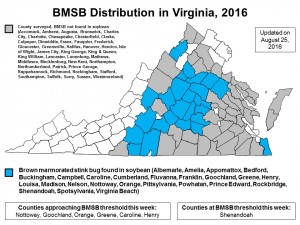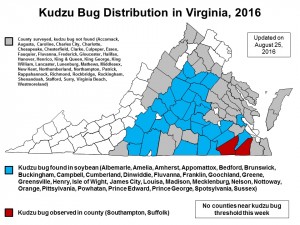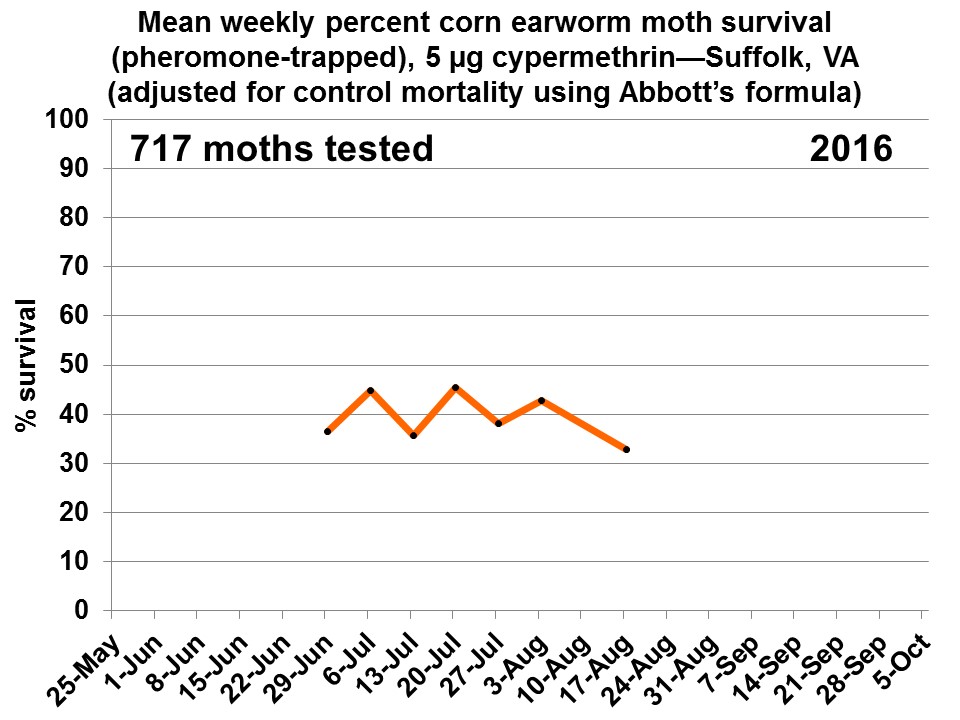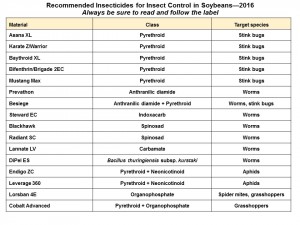This week the Virginia Tech Tidewater AREC entomology program evaluated 298 Helicoverpa zea (=corn earworm/bollworm) moths in the cypermethrin vial tests, with 53.1% surviving the 24-hour exposure to the 5 microgram/vial rate. This brings the seasonal average to 42.9% (based on 1,075 Suffolk-collected moths).
Category Archives: Pest Group
Sugarcane aphid in sorghum: Sep. 1, 2016 update
White sugarcane aphid, Melanaphis sacchari, was found infesting sorghum in New Kent county this week. Thanks to ANR Agent John Allison for submitting the sample. Edit to original post: MIke Arrington and Kayla Babb (Tidewater AREC Entomology) reported finding infestations of M. sacchari in Surry County sorghum, near Bacon’s Castle (this is not on the state map).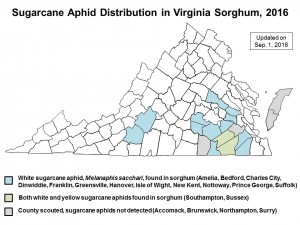
Brown marmorated stink bug and kudzu bug in soybean: Sep. 1, 2016 update
This week, our soybean scouts Ed and Jamie reported two new counties with BMSB this season (Rockingham and Rapphannock). Eight counties had threshold levels of BMSB (3-5 adults+medium & large nymphs per 15 sweeps or 2-minute visual inspection)–see the BMSB map for details. Kudzu bugs were found in one new county–Chesterfield. Over all counties sampled, kudzu bug numbers ranged from zero to 3 per 15 sweeps–still below threshold.
Black light trap captures for the week ending Aug. 25, 2016
Corn earworm/bollworm moth captures in Suffolk averaged 23 per night, but only ranged from < 1 to 4 at other reporting locations this week. Brown marmorated stink bug was only captured at Warsaw (averaging 1.4 per night). Please see the attached data tables for more information. BLT_25_Aug_2016
Sugarcane aphid in sorghum: update for Aug. 25, 2016
Pyrethroid resistance monitoring update for Aug. 25, 2016
BMSB and kudzu bug in soybean: update for Aug. 25, 2016
This past week our scouts found four new Virginia counties with brown marmorated stink bug (BMSB) in soybean (Caroline, Shenandoah, Rockbridge, and Henry). Thresholds for field edges where BMSB is the predominant stink bug species are 3-5 adults + medium and large nymphs per 2-minute visual count, or 3-5 in 15 sweeps. The Shenandoah field (R5 growth stage) that was sampled was above threshold with 8 BMSB per 2-minute count; six counties were approaching threshold (please see the map for specifics).
Kudzu bugs were found in three new counties (Prince George [reported by ANR Agent Scott Reiter), James City, and Franklin). No counties had threshold levels of kudzu bugs (threshold is one nymph per sweep, which equals 15 nymphs per 15 sweeps).
Vial test results for Aug. 18, 2016
Black light trap report for Aug. 18, 2016
In general, corn earworm moth counts were similar to last week; brown marmorated stink bug counts were low (moderate in Warwaw). Please see the attachment for more details: BLT_18_Aug_2016
Corn earworm soybean update.
In both 2014 and 2015 we experienced very light corn earworm (CEW) infestations in our soybean crop. This summer we are back to a more normal situation with spotty light to moderate level infestations. Some fields have hit thresholds for sure, but not all. And, as is the case in most years, worms are in some fields that are only in the flowering stage—which has been proven many times over the years NOT to be a problem, that is, does NOT result in any yield loss. CEW do their damage when they feed on developing seed during the R5-R6 growth stages. If needed, a single application (if the right insecticide is used) during this stage should be all that is needed for season-long CEW control.
As always, in a year with spotty infestations, it pays to scout fields carefully to find those at threshold so they can be protected. We have recently proven that pyrethoid insecticides have a devastating effect on the thousands of beneficial insects and spiders in a soybean field. If left alone, they have then potential to control CEW infestations by eating the eggs and small worms and therefore prevent the need for an insecticide spray. So, be careful with pyrethroid applications and use them only if thresholds are met. You will very likely save money in the long run.
What are the thresholds for CEW in soybean? There is not a one-size-fits-all answer. This fact sheet Soybean_insect_mgmt_2016 has a CEW Calculator that can provide a good answer based on some of the factors that must be considered—like the estimated application cost and bushel value. Use this as a starting point.
What to treat with? We have been monitoring CEW for pyrethroid insecticide resistance for several years by collecting and testing adults (moths). This year is no exception. Individual moths are exposed to a pyrethroid and we document the percent that survive (=resistant). This year we are seeing high levels of survivorship averaging about 40% over all sample dates and locations. This means that to achieve good CEW control, non-pyrethoids insecticides should be considered. For CEW, I would focus on those that ‘specialize’ in worm control (like Prevathon, Besiege, or Spinosad). Lannate is another option but has essentially zero residual activity, whereas the others should provide several days of protection, depending on rainfall amounts and frequency. If stink bugs are also present in the field, the worm products will not be effective. A pyrethroid will need to be tank mixed with the worm product (example, Prevathon plus bifenthren)—or a product like Besiege can be used that contains both a worm product and a pyrethroid. Below is a list of insecticides labeled for use in soybean.

